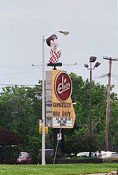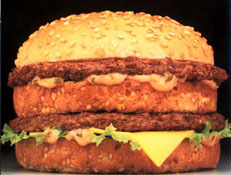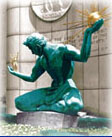
|
MichiganDetroitWhere I Was Born
|
Birmingham | Beverly Hills | Detroit
Introduction

For a great list of online articles and photos of past Detroit, please visit The Detroit News Rearview Mirror.
Detroit History
Detroit (city, Michigan), city in southeastern Michigan and seat of Wayne County. Detroit, the largest city in the state, is a port of entry located on the Detroit River and Rouge River, opposite Windsor, Ontario, Canada.
The Detroit area is the world's foremost automobile manufacturing center, giving Detroit its nickname The Motor City, and is one of the nation's leading industrial centers.
Population
Detroit is the core of a major metropolitan area, although the population of the city proper is in decline.
Detroit's population dropped from 1,203,399 in 1980 to 1,027,974 in 1990 and to an estimated 992,038 in 1994.
According to the 1990 census, blacks constitute 75.7 percent of Detroit's population; whites, 21.6 percent; Asians and Pacific Islanders, 0.8 percent; and Native Americans, 0.4 percent. Hispanics, who may be of any race, represent 2.6 percent of the population.
History
The first automobile factories were founded in 1897 and 1903 by such pioneers as Ransom Eli Olds and Henry Ford. The development of mass production and the emergence of a growing middle-class market for automobiles occurred in the 1910s and 1920s.
The population of the city continued the rapid growth begun in the 1840s, largely through immigration of Germans, Irish, and Poles, who became Detroit's largest ethnic group. During and after World War I (1914-1918), Detroit attracted large numbers of Southern blacks seeking better opportunities.
The automobile industry suffered severely in the 1930s during the Great Depression. In 1936 and 1937, labor organizing and strikes by auto workers at the huge General Motors plants in nearby Flint resulted in official recognition by major auto manufacturers of the United Automobile Workers of America. This labor action, one of the most significant of the century, affected thousands of auto workers in Detroit and other cities.
During World War II (1939-1945) the automobile industry converted its operations to the manufacturing of military equipment such as tanks, airplanes, and amphibious vehicles, thereby earning the city the title of Arsenal of Democracy.
In the wartime and early postwar years, when the economy was booming, the city experienced another wave of immigration, and reached a peak population in 1957 of about 1,850,000 people.
In the succeeding years, like most United States metropolises, Detroit experienced social upheaval in the form of deteriorating neighborhoods, misguided renewal projects, racial tensions, city bankruptcy, and chaotic urban sprawl. During this period, the population increased in the suburbs, but declined drastically in the city itself. In the summer of 1967 the city was the scene of severe race riots.
Tension eased somewhat in the 1970s, and in 1973 Coleman Young was elected Detroit's first black mayor; he served a record five terms before retiring in 1994. The city showed a certain economic resilience and was somewhat rejuvenated in the 1970s by the building of the Renaissance Center and associated renewal activities. However, it was adversely affected by a downturn in the automobile industry in the early 1980s.
Text source: "Detroit (city, Michigan)," Microsoft (R) Encarta R) 98 Encyclopedia.
The Detroit Institute of Arts
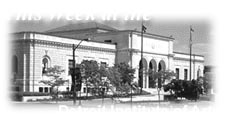
The fifth-largest fine arts museum in the United States.
(Text & photo source: detnews.com/history/rivera/rivera.htm)
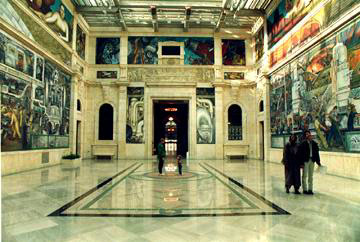
The Rivera Murals
The Detroit Institute of the Arts has an extensive American collection including "Detroit Industry," a 27-panel mural by the Mexican artist Diego Rivera.
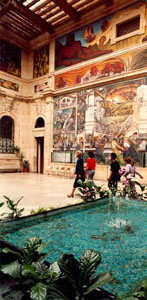
The Garden Court
Comerica Park
New Home of the Detroit Tigers Major League Baseball Team
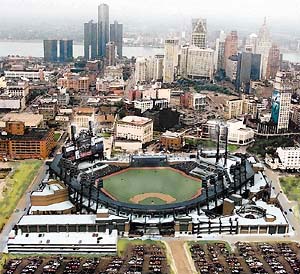
Comerica Park Aerial View
September 5, 1999
Opening Game: April 11, 2000. Address: 2100 Woodward Ave., directly across the street from the Fox Theater (1 mile from old Tiger Stadium).
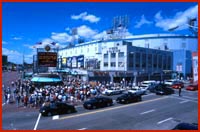
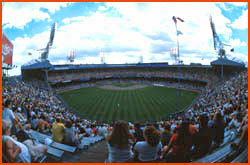
Tiger Stadium
Last Game: September 27, 1999 Address: Corner of Michigan and Trumbull
Source: /www.detroittigers.com/history/tiger_history.html)
Comerica Park Facts and Figures
(Source: /www.detroittigers.com/)
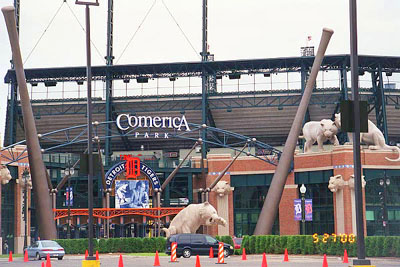
Gated Entrances
There are three main gated entrances to Comerica Park, each featuring attractions on a grand scale. Among the features are immense 80-foot high baseball bats framing the gates, Tiger sculptures, and Pewabic tile accent.
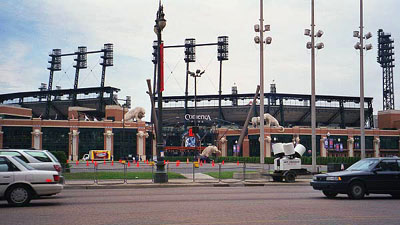
Scoreboard
Comerica Park features a main scoreboard larger than any other facility in existence. The face of the structure, in fact, is equivalent to the size of the face of the Fox Theatre Office Building facing Woodward Avenue (180' wide).
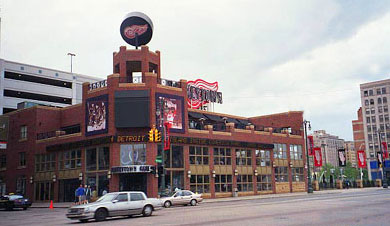
Carousel, ferris wheel and water feature
In the middle of the Big Cat Court, a merry-go-round carousel is available to young fans, with patrons riding atop Tigers instead of horses. Behind the Brushfire Gill stands a baseball-themed ferris wheel. Centerfield features a giant water feature, "Liquid Fireworks," that synchronizes music to spraying fountains of water.
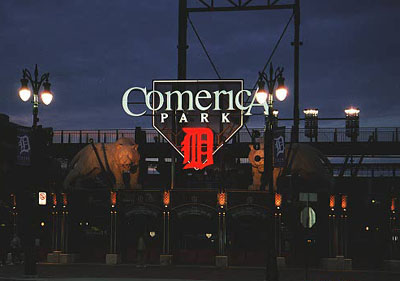
Groundbreaking for the $300 million project took place on October 29, 1997. More than 60 percent of the financing is private, with the rest contributed from public sources.
Detroit's Historic Fox Theatre
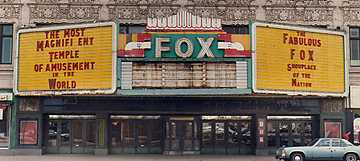
1987
The Fox, which opened on Sept. 21, 1928, as it looked in 1987, just as
renovation was about to begin.
(Text & photo source: detnews.com/history/fox/fox.htm)
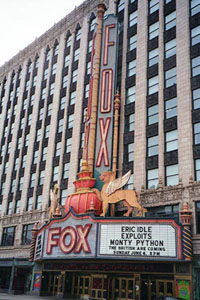
Today
Today, the new 10-story marquee overlooks Woodward Ave
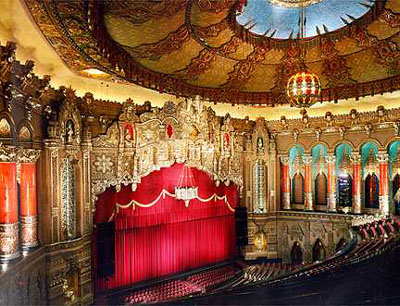
Today
The ornate auditorium has been painstakingly restored to its original
glory.
(Source: detnews.com/history/fox/fox.htm)
The Detroit Medical Center
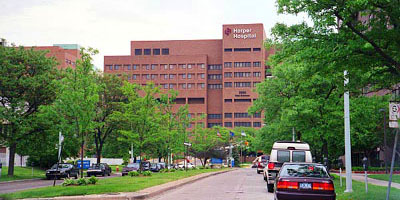
Harper Hospital
3990 John R, Detroit
Where my dad had heart surgery and Joni did her dietetic internship.
Harper Hospital is a 713-bed acute care facility serving adult
medicine and surgery with a major emphasis on the neurosciences. Harper,
founded in 1863 to care for Civil War soldiers, is one of Detroit's oldest
and best known hospitals. Highly regarded for its medical and surgical
specialties.
(Text source: http://www.harperhospital.org/harper/)
The largest health care provider in southeast Michigan, the Detroit
Medical Center (DMC), operates eight hospitals, two nursing centers
and more than 100 outpatient facilities. The DMC is the academic
health center of Wayne State University.
(Text source: www.neurosurg.wayne.edu/dmc.html)
Downtown J. L. Hudsons
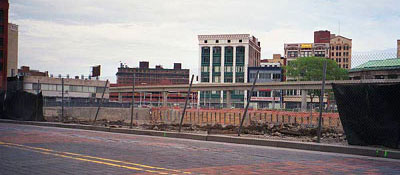
Former Site of Hudson's Department Store.
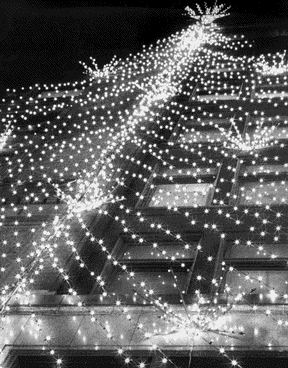
Christmas Lights
Thousands of lights on the side of the Hudson's building herald the Christmas
season in 1961.
(Source: detnews.com/history/hudson/hudson.htm)
Elias Brothers Restaurants
|
|
|
The History of Elias Brothers - In 1936, the owner of a small
restaurant in California introduced the "Big Boy Burger," the original
double-decker hamburger with fresh toppings and special sauce.
A few years later, the three Elias brothers from Michigan met with the
restaurateur and became part of the first family restaurant franchise
in the country, Big Boy Restaurants. In 1987, Elias Brothers became
the worldwide franchisor of Big Boy Restaurants, Inc.
(Source: www.bigboy.com/bigboyemp.html)
Belle Isle
Belle Isle is an island park in the Detroit River connected to the city by bridge and containing an aquarium, a conservatory, and a lighthouse (all designed by Albert Kahn), beaches, and a children's zoo. (Source: "Detroit (city, Michigan)," Microsoft (R) Encarta (R) 98 Encyclopedia.)
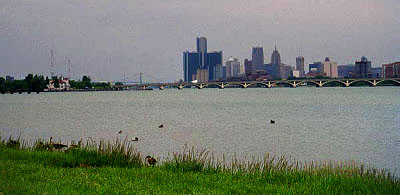
Belle Isle Bridge
Viewed from Belle Isle. The Ambassador Bridge is in the background.
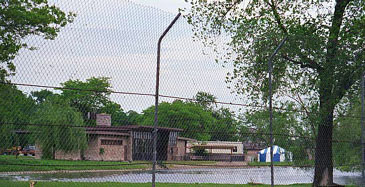
Ice Skating Pavilion
When we were kids, my parents used to take us ice skating here.
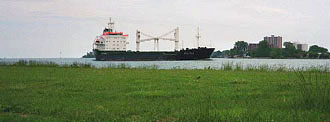
Great Lakes Freighter
My dad used to log the great-lakes freighters, such as the one pictured above. Lake Saint Claire is on the left and Windsor is across the river. Detroit is the busiest port in Michigan and is one of the busiest inland waterways in the world.
Leonard B. Smith and
The Detroit Concert Band
(Source: detnews.com/history/band/band.htm )
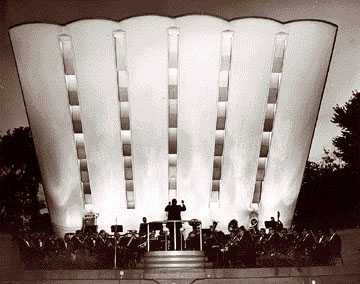
The Remick Band Shell on Belle Isle in 1963.
In 1950 a new $150,000 Belle Isle band shell replaced the old rounded one on a small waterway nestled between the Nancy Brown Carillon Tower and the skating pavilion. Listeners could sit on the rows of green park benches, lie on blankets on the lawn, or sit in their canoes pulled up on the shore. It was named after music publisher Jerome H. Remick, a Detroiter who owned the largest music publishing firm in the world
In 1937 Leonard B. Smith arrived in Detroit from New York City to play with the Detroit Symphony on radio's Ford Sunday Evening Hour, which was carried by 440 CBS radio stations. A champion of the music of John Philip Sousa, he was invited in 1946 by Detroit Mayor Jeffries to leave the symphony and take over the Detroit Concert Band, which played throughout the summer at Belle Isle.
The Belle Isle concerts ended in 1980. The band, however, continued performing at other sites in the suburbs and the State Fairgrounds.
Bob-Lo Island
(Source: detnews.com/history/boblo/boblo.htm)
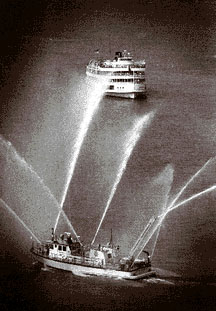
Fireboat Salute
Detroit fireboat salutes the steamer Ste. Claire on a voyage down the Detroit River to Bob-lo.
The boarding dock in Detroit was initially at the foot of Woodward, was moved to behind Cobo Hall, and eventually out of downtown to Gibraltal in 1991.
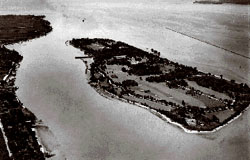
1933
An aerial view of Bob-lo Island taken in 1933, before the amusement park was built.
The Canadian shoreline is at left, Lake Erie at top, and the U.S. shoreline at upper right.
A great part of the romance of Bob-lo Island lay in getting there on the Bob-lo Boat. It took just over an hour and there were moonlight cruises as well as daytime ferries to the island. Bands on the second deck dance floor changed with the times, from Mrs. Walpola's turn of the century music (think Harold Hill) to the Big Bands of the 1940s to the Latin Counts of the 80s.
Bob-Lo Boat
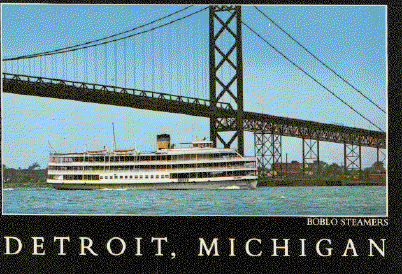
Steamer Columbia
The Steamer Columbia passing under the Ambassador Bridge.
Source: www.steamercolumbia.org/imagegallery.html
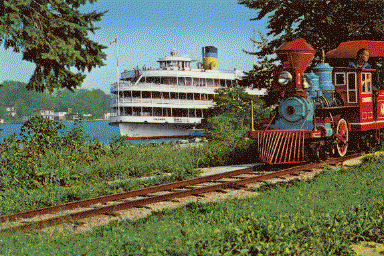
Bob-Lo Train
The Steamer Columbia at the island dock taken from a vantage point that also shows the train that made the ten minute trip around the island.
Detroit's Giant Tire
(Source: /detnews.com/history/stove/stove.htm)
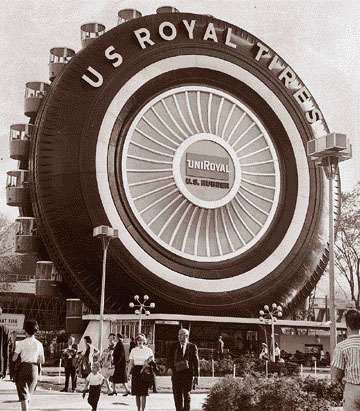
The giant tire began life as a Ferris wheel at the New York World Fair in 1964.
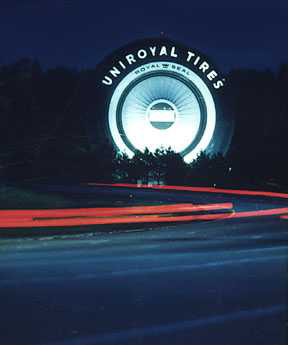
The giant tire as seen by night on eastbound I-94 in Allen Park.
My Dad's Old House
19775 Washtenaw, Detroit
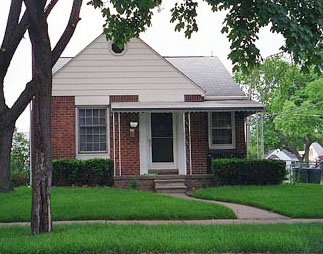
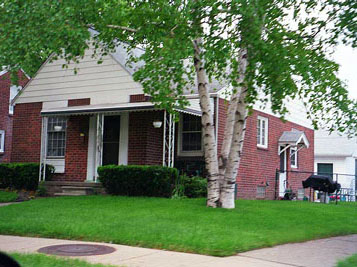
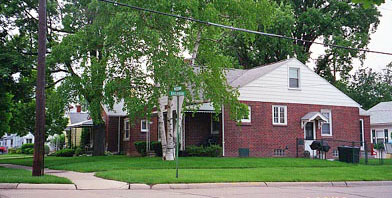
My dad lived here with his family for a few years, before he went into the army.
Henry Ford Museum
Greenfield Village
Dearborn, Michigan, Wayne County
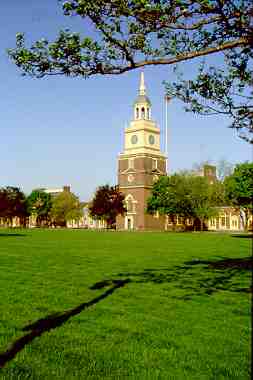
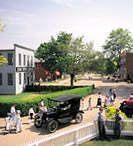
Henry Ford Museum contains one of the most important collections of Americana in the United States. Source: www.hfmgv.org/
Greenfield Village is a precedent setting open-air
outdoor village museum that served as a model in the development of
other such villages across the United States.
Source: www.hfmgv.org/
The Edison Institute, better known as the Henry Ford Museum and
Greenfield Village, is one of America's outstanding museums and
museum villages.
(Source: www.sos.state.mi.us/history/preserve/phissite/greenfie.html)
Dearborn, city in Wayne County, southeastern Michigan, on the
River Rouge, adjoining Detroit. The birthplace of the industrialist Henry
Ford, it is the international development and manufacturing headquarters
of the Ford Motor Company.
(Source: "Dearborn," Microsoft (R) Encarta (R) 98 Encyclopedia.)
City of Windsor
Ontario, Canada
Windsor (city, Ontario), city, seat of Essex County, southern
Ontario, on the Detroit River. A port of entry on the United States-Canadian
border, the city is connected to Detroit, Michigan, by bridge and tunnel.
(Source: "Windsor (city, Ontario)," Microsoft (R) Encarta
(R) 98 Encyclopedia)
Casino Windsor
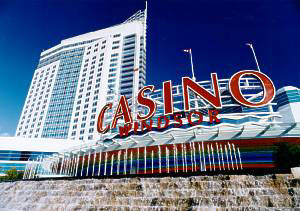
Casino Windsor TM
The new Casino Windsor TM opened to the public on July 29, 1998. It is Ontario's premier commercial casino.
Little Italy, Windsor
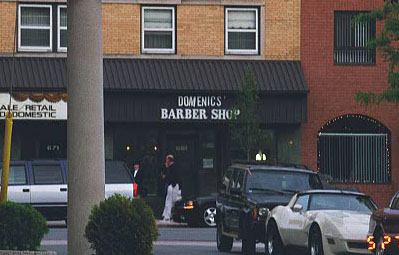
Domenic's Barber Shop
Domenic is spelled same as my dad's first name.
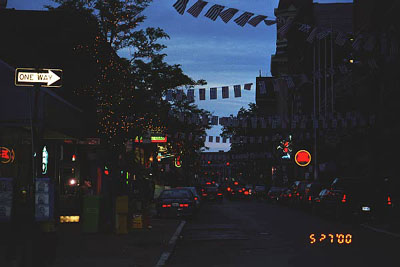
Little Italy Street
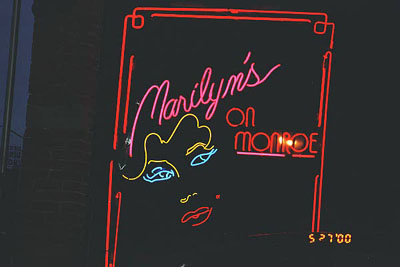
Marilyn's On Monroe
Jackson Park, Windsor
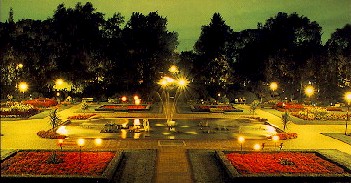
Sunken Gardens
Jackson Park is Windsor's definitive place to slow down and smell the roses, with its breathtaking sunken gardens and reflecting pool.
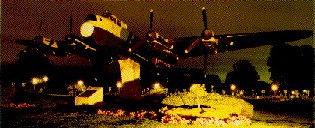
W.W. II Bomber
Jackson Park's experimental rose gardens, where a classic W.W. II Lancaster Bomber stands over dozens of prized and rare rose varieties.
(Source: www.city.windsor.on.ca/cvb/Attractions/natural.asp
Detroit Skyline
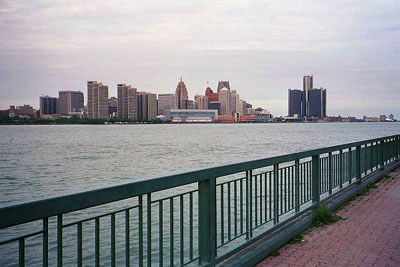
View From Windsor
The Civic Center, the City-County Building; Cobo Hall and
Arena (forefront, orange building) , one of the country's largest convention
halls; Joe Louis Arena (forefront, left of Cobo Hall), home of the Detroit
Red Wings professional ice hockey team; and Hart Plaza are all located
on Detroit's downtown river front. Towering above these facilities is
the Renaissance Center (right), a complex containing a hotel, office buildings,
movie theaters, and shops.
(Text Source: "Detroit (city, Michigan)," Microsoft (R) Encarta (R) 98
Encyclopedia.)
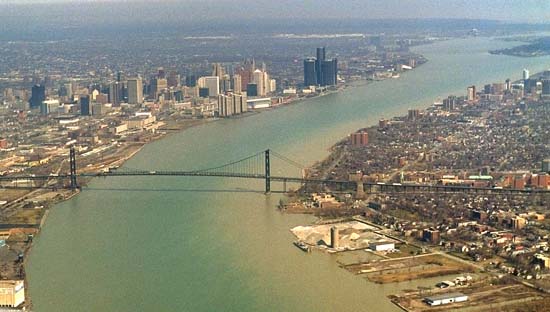
Ambassador Bridge
Continuing northward, the Detroit River bends to the east as it comes under the Ambassador Bridge. This produces the unusual geography of locating Canada to the south of the U.S. The Renaissance Center towers dominate the shoreline to your left, along with Joe Louis Arena, home of the Detroit Red Wings.
[ Top of Page ]
[Back]
[ Return to Photo Albums ]
[ Nancy Ford's Home Page ]
Copyright. All rights reserved. Nancy's Design Studio
